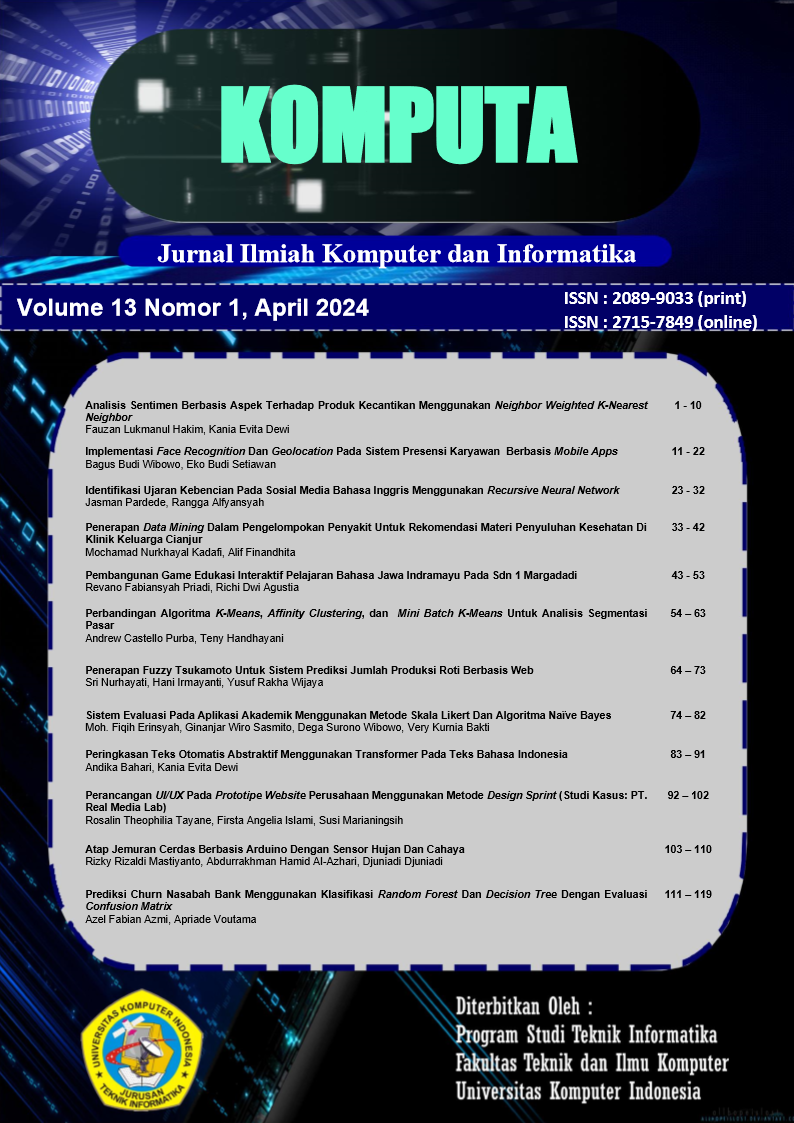Perbandingan Algoritma K-Means, Affinity Clustering, dan Mini Batch K-Means Untuk Analisis Segmentasi Pasar
Main Article Content
Abstract
Segmentasi pasar adalah proses membagi pasar menjadi kelompok-kelompok pembeli yang homogen berdasarkan karakteristik tertentu. Segmentasi pasar penting bagi perusahaan untuk memahami kebutuhan dan perilaku konsumennya sehingga dapat mengembangkan strategi pemasaran yang lebih efektif. Penelitian ini membandingkan tiga metode clustering, yaitu K-Means Clustering, Affinity Propagation Clustering, dan Mini Batch K-Means, dalam konteks analisis segmentasi pasar. Data yang digunakan adalah dataset marketing_campaign.csv yang terdiri dari 29 kolom dan 2240 baris. Eksperimen dilakukan untuk mengevaluasi performa ketiga metode dengan menggunakan metrik siluet. Hasil eksperimen menunjukkan bahwa Affinity Propagation menghasilkan nilai silhouette tertinggi sebesar 0.5861, diikuti oleh K-Means dengan 0.4675, dan Mini Batch K-Means dengan 0.4659. Temuan ini mengindikasikan bahwa Affinity Propagation dapat menjadi pilihan yang baik untuk analisis segmentasi pasar pada dataset tersebut. Hasil perbandingan ini memberikan wawasan tentang keunggulan dan kelemahan masing-masing metode clustering, membantu pemilih dalam memilih pendekatan yang paling sesuai untuk tujuan analisis mereka. Studi ini memberikan kontribusi pada pemahaman praktis penerapan teknik clustering dalam konteks pemasaran.
Article Details
Section
Penulis yang menerbitkan dengan jurnal ini setuju pada persyaratan berikut ini:
- Penulis menyimpan hak cipta dan memberikan jurnal hak penerbitan pertama, dengan pekerjaan 6 bulan setelah penerbitan secara simultan dengan lisensi di bawah: Creative Commons Attribution License yang memudahkan yang lain untuk berbagi karya dengan pengakuan penerbitan awal dan kepenulisan karya di jurnal ini.
- Penulis bisa memasukkan ke dalam penyusunan kontraktual tambahan terpisah untuk distribusi non-ekslusif versi kaya terbitan jurnal (contoh: mempostingnya ke repositori institusional atau menerbitkannya dalam sebuah buku), dengan pengakuan penerbitan awalnya di jurnal ini.
- Penulis diizinkan dan didorong untuk mem-posting karya mereka online (contoh: di repositori institusional atau di website mereka) sebelum dan selama proses penyerahan, karena dapat mengarahkan ke pertukaran produktif, seperti halnya sitiran yang lebih awal dan lebih hebat dari karya yang diterbitkan. (Lihat Efek Akses Terbuka).
How to Cite
References
C. Yuan and H. Yang, “Research on k-value selection method of K-Means clustering algorithm,” Third Internatinal Symposium on Inteligent Information Technology and Security Informatics, vol. 2, pp. 226-235, 2019.
V. V, “Customer Segmentation Using Machine Learning,” International Conference on Computational Techniques, Electronics and Mechanical Systems(CTEMS), vol. 08, 2021.
K. Dhiraj, “Implementing Customer Segmentation Using Machine Learning [Beginner Guide],” Hohhot, 2021.
K. R. Shahapure and C. Nicholas, “Cluster Quality Analysis Using Silhouette Score,” in IEEE 7th International Conference on Data Science and Advanced Analytics (DSAA), Sydney, 2020.
V.Vijilesh, “CUSTOMER SEGMENTATION USING MACHINE LEARNING,” International Research Journal of Engineering and, vol. 08, 2021.
Z. Xu, Y. Lu and J. Yu, “Research on Mini-Batch Affinity Propagation Clustering Algorithm,” in IEEE 9th International Conference on Data Science and Advanced Analytics (DSAA), Shenzhen, 2022.
M. M. Amini and H. Amini, “A comparison of K-means, Mini-batch K-means, and Gaussian mixture models for customer segmentation,” Journal of Business & Economic Research, Vols. 17(2), 1-13, 2019.
d. V. V. Werner, “Imbalanced data preprocessing techniques for machine learning: a systematic mapping study,” Knowl. Inf. Syst., 2023.
I. T. Jolliffe, “Principal component analysis,” Springer, 2020.
A. Mahapatra, A. M. B. Nanda, A. Padhy and I. Padhy, “Concept of outlier study: The management of outlier handling with significance in Inclusive education setting,” Asian Research Journal of Mathematics, pp. 7-25, 2020.
S. S, X. L, R. L, G. F, L. S, W. Z and X. R, “An efficient density-based local outlier detection approach for scattered data,” IEEE Access, vol. 7, 2020.
Y. Roh, G. Heo and S. E. Whang, “ A Survey on Data Collection for Machine Learning: A Big Data - AI Integration Perspective,” IEEE Transactions on Knowledge and Data Engineering, vol. 1, 2019.
K. Phiwhorm, C. Saikaew, C. Leung, P. Polpinit and K. Saikaew, “Adaptive multiple imputations of missing values using the class center,” Big Data, vol. 9, no. 52, 2022.
M. Hasan, M. Alam, S. Roy, A. Dutta, M. Jawad and S. Das, “Missing value imputation affects the performance of machine learning: A review and analysis of the literature,” Inform. Med. Unlocked, vol. 27, 2021.
T. Boeckling, G. De Tre and A. Bronselaer, “Cleaning Data With Selection Rules,” IEEE Access, vol. 10, 2022.
V. Viallon, M. His, S. Rinaldi, M. Breeur, A. Gicquiau, B. Hemon, K. Overvad, A. Tjønneland, A. Rostgaard-Hansen and J. Rothwell, “A New Pipeline for the Normalization and Pooling of Metabolomics Data,” Metabolites, vol. 11, 2021.
B. Deng and X. Li, “A novel normalization method for imbalanced data classification based on deep learning,” Expert Systems with Applications, vol. 16828, p. 199, 2022.
V. Eric, K. Angel and G. Helena, “Measuring the effect of categorical encoders in machine learning tasks using synthetic data,” pp. 92-107, 2021.
A. A. Abu-Hassan and H. Al-Yaqout, “A novel parameter estimation approach for clustering imbalanced data,” Expert Systems with Applications, vol. 113792, p. 116, 2020.
R. Ketan, “Cluster quality analysis using silhouettescore,” M.S. Writing Project, Department of Computer Scienceand Electrical Engineering, 2020.
M. Rodriguez, C. Comin, D. Casanova, O. Bruno, D. Amancio, L. Costa and F. Rodrigues, “Clustering algorithms: A comparative approach,” PLoS ONE, vol. 14, 2019.
C. Patil and I. Baidari, “Estimating the optimal number of clusters k in a dataset using data depth,” Data Sci, vol. 4, pp. 132-140, 2019.
R. S. K and N. C, “Cluster quality analysis using silhouette score,” 2020.
T. Liu, H. Yu and R. Blair, “Stability estimation for unsupervised clustering: A review,” Comput. Stat., vol. 14, 2022.

